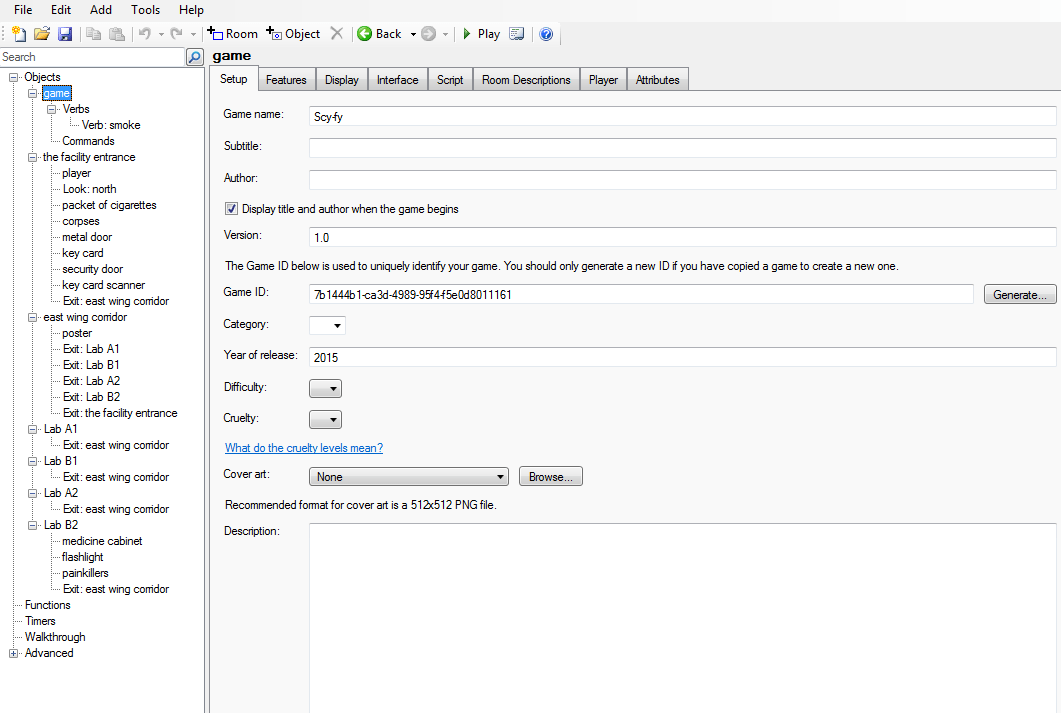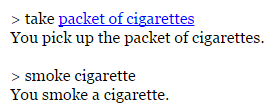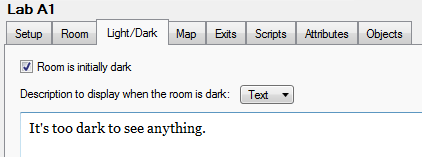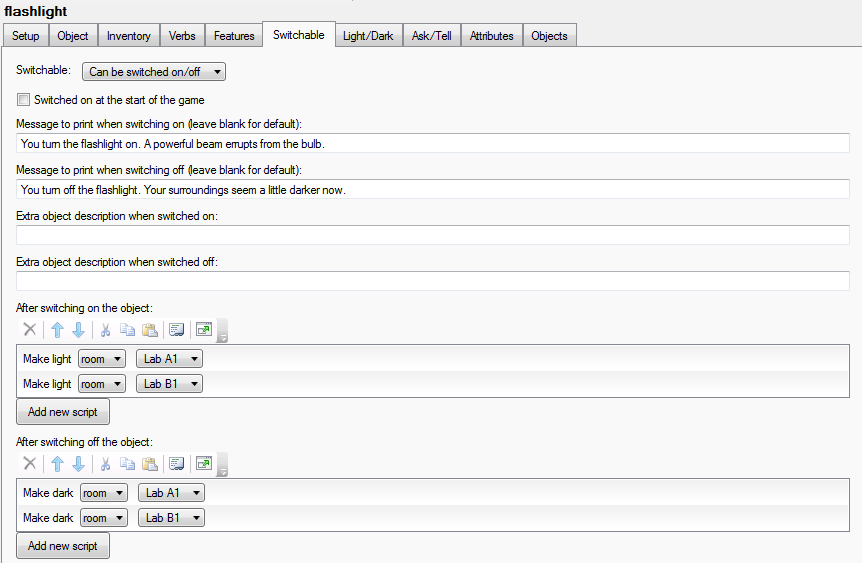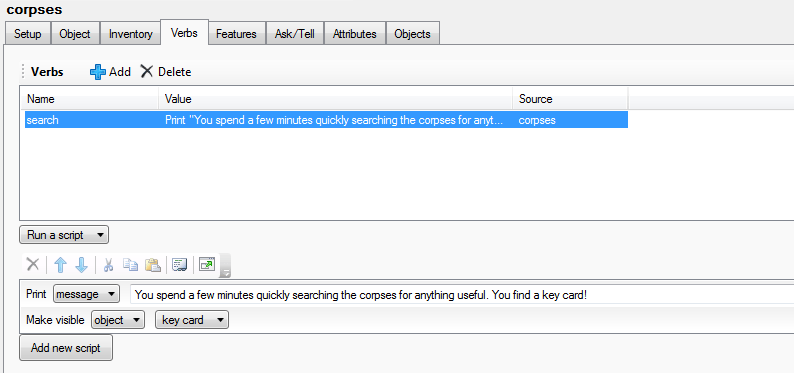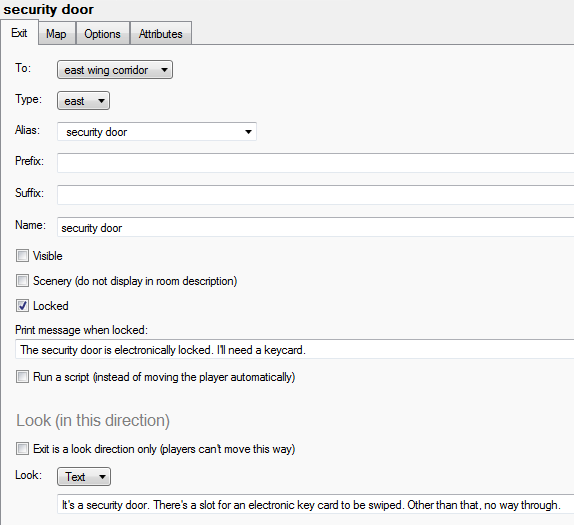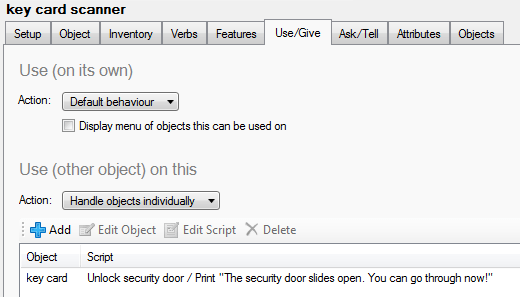Until recently, my first thoughts for this project were to create a point and click adventure game in the style of games such as Monkey Island. Unfortunately, I’ve never made a game before, and the software I originally had in mind to use – the Unity engine, is far beyond my capacity to learn. While looking at tutorials and downloading the program itself did nothing much to help. It wouldn’t be far from the truth to say that I perhaps took on a lot more than I could chew, and for this reason I’m pulling away from the idea of a point and click adventure, and instead going to focus my efforts on creating a text-based adventure game like Infocom’s The Hitchiker’s Guide to the Galaxy, released in 1984. A remastered version of which can be played for free on the BBC website: http://www.bbc.co.uk/programmes/articles/1g84m0sXpnNCv84GpN2PLZG/the-hitchhikers-guide-to-the-galaxy-game-30th-anniversary-edition
The software I’m going to use to create my game is Quest, (http://textadventures.co.uk/quest) an open-source text adventure engine which makes the process as easy as possible, with a click-interface of pre-set variables and options to make the development process easier. There may still be some light coding involved, but not as much as would be necessary if I wished to create a point and click as originally intended.
To get familiar with the program, I looked at the tutorials which can be found here http://docs.textadventures.co.uk/quest/tutorial/, and made a small-mock up of various mechanics and systems in an attempt to become familiar with the program.
The image above shows the main game window for my very first creation. As you can see, I added various rooms and objects as a way of experimentation.
I included these cigarettes as a way of experimenting with implementing my own verbs. In this case “smoke”. Meaning that should the player decide to type “smoke cigarette”, then the character will smoke a cigarette. I’m going to try to implement object counts so that the player can only use so many before they run out. As you can see above as well, smoking a cigarette will temporally make a room brighter, but a timer needs to be implemented so that this is only for a matter of seconds.
Here it is working in-game.
I made this room dark to test ways of implementing this as an obstruction or a puzzle for the player character to solve and just generally how the light/dark mechanics work.
This is the flashlight, which works as a portable light source for the player, and can also be switched on and off. Turning it on makes scripted rooms brighter, meaning the player can navigate.
This image shows my further experiments with the verb menu; including a “search” command for some corpses. Furthermore, doing so reveals a key card to unlock the room’s exit.
This is the exit in question; a locked security door that can only be opened with the key card found previously. This served as experimentation both using locked exits and also using items on one another. (see below)
Finally, below we have an example of a container. This is an object that can hold other objects inside, meaning I could perhaps implement such a system as a puzzle or a form of item-management for the player.
————————————————————————————————————
This screenshot shows the main screen of the Quest development software and the main details of the game I’m creating. On the left-hand side can be seen all of the rooms and objects that currently exist within the game and what they’re linked to, while on the right are the details and available options and sub-menus.
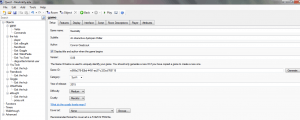
For someone like myself who is inexperienced with creating games, Quest provides an opportunity for me to create a simple game with a minimum of coding knowledge. Using the basics of adventure game design as outlined in the book Game Design by Andrew Rollings and Ernest Adams, I believe I can create a high-quality, albeit short, text adventure game.
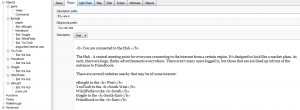
This screenshot showcases the main development window of a “room”, each tab controlling a different aspect. For instance the tab viewable in the screenshot is the “room” tab, which lets me enter the specific description for the room. Other tabs of note are “light/dark” which enables me to change the light levels of a room, creating a potential obstacle or puzzle for the player to overcome. The “exits” tab allows me to create exits from the current room and link them to already existing or new rooms, which in turn increases the map size for the overall game. “Scripts” allows me to run automatic scripts upon entering the room which, for instance, could be anything from having other characters moving around, creating a time limit or having the game print a unique message only once.
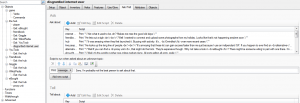
here you can see the ask/tell menu. Using scripts and keyword identification, it is possible to ask or tell an NPC (Non-player character) within the game about certain topics to create the illusion of conversation. In early text adventure games like Hitchiker’s Guide to the Galaxy, it could often be difficult for the player to figure out what to ask other characters due to the preciseness needed when asking a question, and the lack of indicators to show what topics can be spoken about. In an attempt to subvert this, I’ve made discussable topic keywords bold in an attempt to give the player some guidance.
As can be seen in the screenshot above, this is a pre-scripted response to the player asking the character “disgruntled internet user” or simply “user” about the “hub” – the first room in the game. The user then responds with the line that can be seen in the screenshot. As shown, the word “dwindled” in in bold; indicating that the player should as the character about this. Due to the key-word system Quest uses, it would also be okay to simply use “dwindling” or “dwindle”.
An example of the in-game interaction would be as follows:
Player: ask user about hub
NPC: “It was amazing when they first launched it. Buzzing with activity. It’s… Dwindled over more recent years.”
Player: ask user about dwindling
NPC: ” “Well ever since the internet became a more constrained and controlled place, not many old users hang around longer than they need to.”
The same conversation can also be seen in-game below.

The screenshot also shows the examination system, which lists the description of an object (including other characters) when the player “looks” or “examines” them. This gives me an opportunity to provide hints and direction without breaking the flow or immersion of the experience. As can be seen in the screenshot, the description reads
“It’s another internet user, ID says his name is Matthew Clarke. He’s waiting behind the large line of people for access to Friendbook, which he doesn’t seem too happy about. Might be worth asking him about some stuff, perhaps a faster way to access Friendbook.”
Within this description, I introduced another character (“his name is Matthew Clarke”), introduced context into the situation (“He’s waiting behind a large line of people for access to Friendbook”), gave the player an objective (“Might be worth asking him about some stuff, perhaps a faster way to access Friendbook.”) and with the same sentence, some guidance on what to do next.
In my next post, I’ll be showcasing further developments and a preview of a more-or-less fully completed “quest”.
